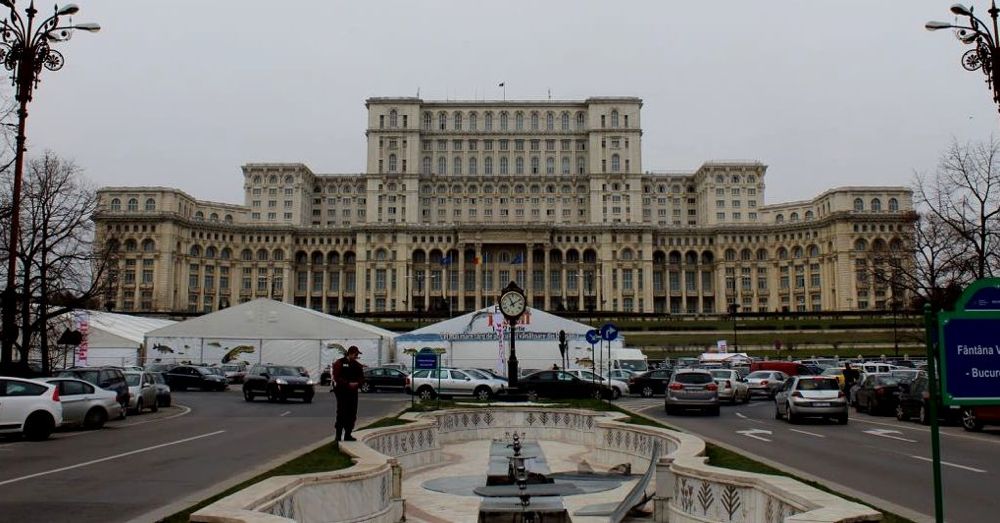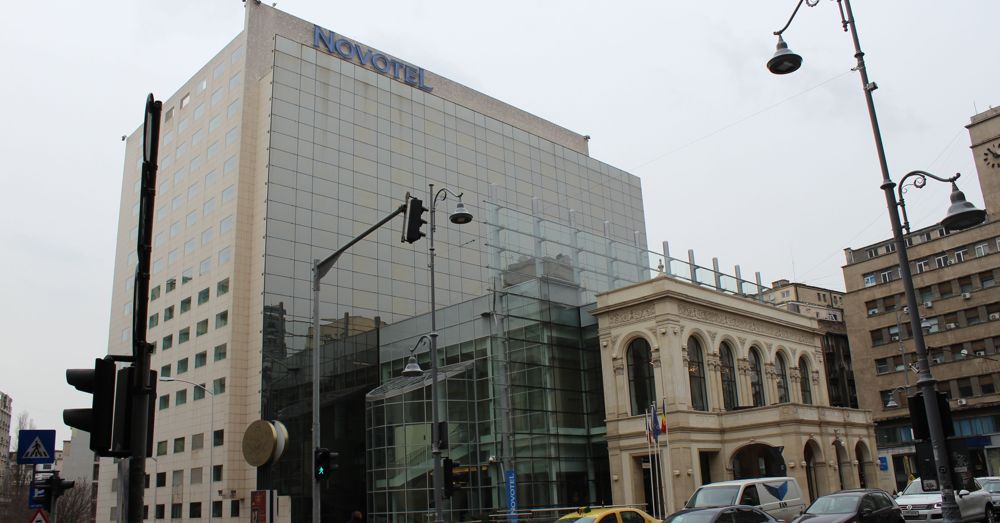Friday, 20-03-2015. Day 212.
Walking Around Bucharest in the Rain (During a Solar Eclipse)
We knew next to nothing about Romania, so through our friends at Bucharest Boutique Accommodations, we signed up for a walking tour of Bucharest with Alexandra of Roaring Romania, who gave us an excellent, all-day tour of Bucharest (and some great recommendations for us to explore in Brasov a few days later).
As we walked, Alexandra told us about Romania's turbulent past. Since the end of World War II until 1989, it was a communist country. Its fate was decided at Yalta — Russia got Romania in exchange for the Allies to retain Greece (the birthplace of democracy after all).
But communism ended (sort of ... ) when the people got fed up with General Secretary Nicolae Ceaușescu (more on him later). He and his wife met their demise on the business end of a firing squad in 1989.
Under Ceaușescu’s watch rule, many of Bucharest's long-standing churches and historic buildings were laid to waste to build Ceaușescu's vision of what he wanted the city to look like. This included making the Boulevard of Unification into a Romanian Champs-Élysées.
After Alexandra showed us a closer look at the Palace of Parliament, we walked through Cișmigiu Park, which had, among other things, a children's playground.
It had been some time since the girls had seen, let alone been able to play on, anything like this, so we let them run wild for a while. As we explored the park, it started to lightly rain. We'd been prepared for that, so it wasn't a big deal — except that meant we weren't able to view the partial solar eclipse that was happening (this was March 20). The sky was so overcast we couldn't see anything aside from the occasional dull glow of a partially obscured sun from behind the clouds.
Adjacent to Cișmigiu Park, we saw a gothic-style castle — the kind you think of when you think of haunted mansions. To the best of my knowledge, this one isn't haunted, though. It was originally built for the Crețulescus, a boyar (Romanian noble) family, in the early 20th century. They don't own it any longer, though. For a while it was a UNESCO school, but that closed a few years back so now it sits there, being spooky.
Speaking of spooky, on our way to lunch, we walked by a statue honoring Vlad Tepes, the infamous "impaler" on whom the legend of Dracula may have been based. Even though he was a pretty cruel fellow (you don't get called the impaler for inviting people to tea), he's considered a national hero because he kept the Ottoman Turks from invading Romania in 1462. More on old Vlad a bit later.
After eating a big lunch at Caru' Cu Bere (which means beer wagon), one of the only beer halls that stayed open during communist rule, we went back into the rain to explore more of the city.
Stavropoleous Monastery
The predominant religion in Romania is Eastern Orthodox, and there are many small churches and monasteries in Bucharest, and one of these is the Stavropoleous Monastery.
This small but ornate monastery for nuns in the heart of Bucharest dates back to 1724. It’s dedicated to the archangels Michael and Gabriel and is known for its large library of Byzantine music books.
From there, we walked down Victory Boulevard back through Bucharest to Revolution Square where we learned about Romania's violent transition from a communist country to a democracy in 1989.
Ceaușescu's Last Stand
Romania was a communist country until 1989, and the defining moment of its transition to a democracy was then General Secretary Nicolae Ceaușescu's final speech, which was given from the balcony in the picture above. During this speech (which you can watch on YouTube) the Romanian Revolution began.
Memorial of Rebirth
People call the controversial monument named Memorial of Rebirth the "potato on a stick," and some liken it to Vlad Tepes — the spike represents the people impaling the tangled mass of communism. Or something.
There's one unofficial, added touch you can see on the photo above—someone vandalized the monument with a bullet of red paint from a paintball gun. It hadn't yet been cleaned, so it looked like there's a bleeding wound at the top of the monument.
One of the strangest building we saw was the Novotel Hotel. It's built on the site of the former National Theater that was destroyed by bombing in World War II. The front entrance is a reproduction of the old National Theater's facade, but behind that is a glass and steel foyer and then a modern high-rise that houses the hotel's rooms. It looks odd, but there were a lot of buildings like this one — a mix of an historic building with something slick and contemporary. In some ways, it's a reflection of Bucharest itself, one foot firmly in the past and one foot stepping boldly into a modern future.
Another great example of this is the headquarters of the Union of Romanian Architects (now a hotel). Under communist rule, this building was the former headquarters for Department 5 (communist Romania's version of the KGB). It was damaged in the revolution and fixed up with a design so modern people call it The Jar or The Cyborg.
There are still plenty of cool old buildings, though, like Cretsulescu Church, located right next to Revolution Square. It was built at the behest of the daughter of a Wallachian prince in 1724 and was on the list of buildings to be destroyed during the Ceaușescu regime, but somehow made it through intact.
Romanian Athenaeum
Another building that made it through the communist regime is one of the coolest building in the city — the Romanian Athenaeum.
For a long time (since 1888), the Athenaeum had been the city's main concert hall. During communist rule, many of the paintings and frescoes in Bucharest's churches and older buildings were destroyed or plastered over. But, for some reason, the interior Athenaeum was spared. Instead, the paintings were only covered up with draperies. We didn't go inside to see it, but by all accounts, it's a beautiful sight.
There are also a number of old Romania castles in Bucharest, many of which have been re-purposed into museums or even casinos (there seemed to be a lot of casinos in Bucharest). One, in particular, was decorated with gilded statues and stonework, but no one lived there — the owner was spending a little time in jail for some sort of money-based illegal activity. Still other castles were were all but deserted. Alexandra led us down some side streets where we saw some fantastic old castles that were in a sorry state.
We ended the day at the famous Hotel Capsa, where the famous and elite of Europe went to play in the 19th century. We were there, however, to visit the Casa Capsa sweet shop next door and try some of their famous confections they create there. Naturally, they were delicious.
As the day wound down to an end, we got a tutorial in how to use the Bucharest Metro (pretty much like any other Metro) and rode it back to our B&B, tired, a little damp, and still full for out lunch at Caru' Cu Bere.
Our tour from Alexandra of Roaring Romania (RoRo) was fantastic. If you're traveling to Bucharest and would like to see some great sights and learn about Romania's history, both its distant past and recent turbulent transition to democracy, consider booking a tour with Roaring Romania.

Tom Fassbender is a writer of things with a strong adventurous streak. He also drinks coffee.



















